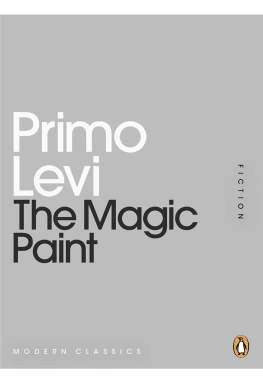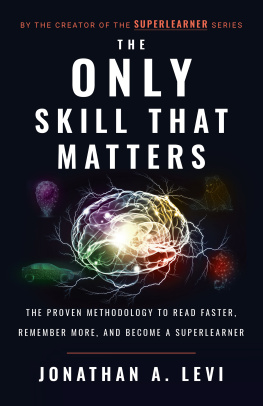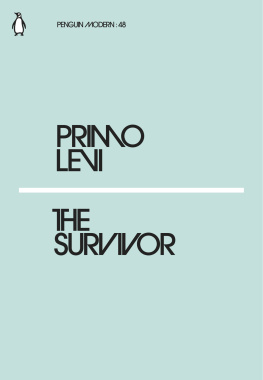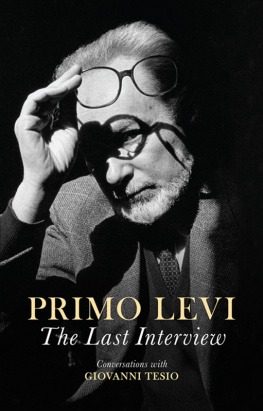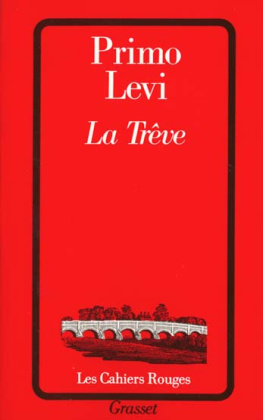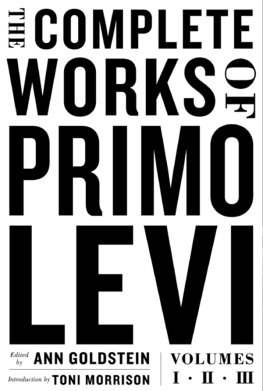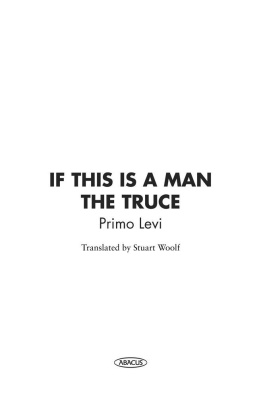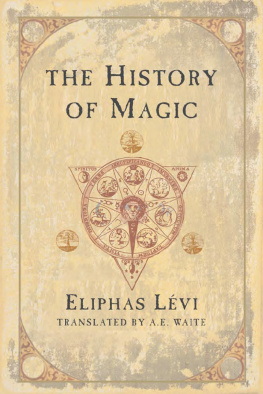He was blamed for endless disasters, from failed exams to a bridge collapse, an avalanche, even a shipwreck: all due, in the stupid opinion of, first, his fellow-students and, later, his colleagues, to the penetrating power of his evil eye
PRIMO LEVI
Born 31 July 1919 , Turin
Died 11 April 1987 , Turin
The Death of Marinese (1949), Censorship in Bitinia (1961), Knall (196870), The Magic Paint (1973), Gladiators (1976), The Fugitive (1979), Bureau of Vital Statistics (1981) and Buffet Dinner (1977) first published in English in book form in A Tranquil Star, 2007.
ALSO PUBLISHED BY PENGUIN BOOKS
The Periodic TableMoments of ReprieveIf Not Now, When?A Tranquil Star
PRIMO LEVI
The Magic Paint
TRANSLATED BY ANN GOLDSTEIN,
ALESSANDRA BASTAGLI AND
JENNY MCPHEE
PENGUIN BOOKS
PENGUIN CLASSICS
Published by the Penguin Group
Penguin Books Ltd, 80 Strand, London WC2R 0RL , England
Penguin Group (USA), Inc., 375 Hudson Street, New York, New York 10014, USA
Penguin Group (Canada), 90 Eglinton Avenue East, Suite 700, Toronto, Ontario, Canada M4P 2Y3 (a division of Pearson Penguin Canada Inc.)
Penguin Ireland, 25 St Stephens Green, Dublin 2, Ireland (a division of Penguin Books Ltd)
Penguin Group (Australia), 250 Camberwell Road, Camberwell, Victoria 3124, Australia
(a division of Pearson Australia Group Pty Ltd)
Penguin Books India Pvt Ltd, 11 Community Centre, Panchsheel Park, New Delhi - 110 017, India
Penguin Group (NZ), 67 Apollo Drive, Rosedale, North Shore 0632, New Zealand
(a division of Pearson New Zealand Ltd)
Penguin Books (South Africa) (Pty) Ltd, 24 Sturdee Avenue, Rosebank, Johannesburg 2196, South Africa
Penguin Books Ltd, Registered Offices: 80 Strand, London WC2R 0RL , England
www.penguin.com
Selected from A Tranquil Star published in Penguin Classics 2007
This selection published in Penguin Classics 2011
Copyright W. W. Norton & Company, Inc., 2007
Translation copyright Ann Goldstein and Alessandra Bastagli, 2007
Censorship in Bitinia translation copyright Jenny McPhee, 2007
All rights reserved
Except in the United States of America, this book is sold subject to the condition that it shall not, by way of trade or otherwise, be lent, re-sold, hired out, or otherwise circulated without the publishers prior consent in any form of binding or cover other than that in which it is published and without a similar condition including this condition being imposed on the subsequent purchaser
ISBN: 978-0-14-197108-7
The Magic Paint
For many years now I have been engaged in the manufacture of paints and, more precisely, their formulation: from this art I earn my sustenance and support my family. Its an ancient and noble art: the earliest reference appears in Genesis 6:14, where it is related how, in obedience to an exact specification on the part of the Almighty, Noah (probably using a brush) covered the Ark, inside and out, with pitch. But its also a subtly fraudulent art, which tends to hide the substratum, endowing it with the color and the appearance of what it is not: in this it is related to the arts of makeup and costume, which are equally equivocal and equally ancient (Isaiah 3:16 ff).
The most varied demands are constantly being made on those who practice this profession of ours: paints that do not conduct electricity and paints that do, paints that transmit heat or reflect it, that keep mollusks from adhering to hulls, that absorb sound, or that can be removed from a surface like a peel from a banana. People require paints that keep feet from slipping, as for airport steps, and others as slippery as possible, as for the bottoms of skis. We are therefore a versatile people, with vast experience, who are accustomed to both success and the lack of it, and are difficult to surprise.
Nonetheless, we were surprised by a request that came from our agent in Naples, Signor Amato Di Prima: he was pleased to inform us that an important client in his area had experimented with a paint that provided protection from misfortune, and would profitably replace horn amulets, hunchbacks, four-leaf clovers, and charms in general. It had not been possible to glean other information, except for the price, which was very high; he had, however, managed to obtain a sample, which he had already sent by mail. Given the exceptional interest of the product, he urgently beseeched us to devote the greatest attention to the problem, declared his faith in a quick response, and extended his most sincere greetings.
This business, of the miraculous sample that arrives in the mail, along with an urgent prayer to devote et cetera (that is, without resorting to euphemism, to copy it), is part of our work, and constitutes perhaps its most obscure aspect. We would like to do things our own way: make our own choice, of a refined and elegant problem, take off on the hunt, sight the solution, pursue it, corner it, spear it, strip it of everything inessential, make it in the laboratory, then manufacture it on a small scale, and finally go into full production and get money and glory from it. But that almost never happens. There are many of our kind in this world, and our colleagues and rivals in Italy, in America, in Australia, in Japan are not exactly dozing. We are awash in samples, and we would happily yield to the temptation to throw them away or return them to the sender, were it not for the consideration that our own products suffer the same fate, becoming, in their turn, marvelous, being shrewdly seized and smuggled out by the agents of our competitors, scrutinized, analyzed, and copied: some badly, others well by the addition, that is, of a particle of originality and genius. Thus begins an endless network of espionage and cross-fertilization, which, illuminated by solitary creative flashes, constitutes the foundation of technological progress. In short, the samples of the competition cannot be thrown out with the dregs: one must see whats there, even if the professional conscience puts up a struggle.
The paint that came from Naples, at first glance, did not display any special property: appearance, odor, drying time were those of a common clear acrylic enamel, and the whole business stank of a hoax. I telephoned Di Prima, who was indignant: he was not the type to send samples around just for fun, and that one in particular had cost him time and trouble the product was extremely interesting and in his market he was having incredible success. Technical documentation? It didnt exist, there was no need for it, the effectiveness of the product spoke for itself. A fishing boat had been coming back with empty nets for three months they had painted its hull and ever since it had been netting spectacular catches. A typographer had mixed the paint with printing ink: the ink didnt go as far, but the typographical errors had disappeared. If somehow we were unable to use it, we should tell him immediately; otherwise, we should get busy with it. The price was 7000 lire a kilo, which seemed to him a good profit margin, and he would undertake to sell at least twenty tons a month.
I talked about it with Chiovatero, who is a serious and capable fellow. At first he turned up his nose, then he thought about it, and proposed starting simply; that is, trying the paint on cultures of E. coli bacteria. What did he expect? That the cultures would multiply more than the controls or less? Chiovatero was annoyed, and told me that it was not his habit to put the cart before the horse (implying, by this, that it was my habit, which, for goodness sake, is absolutely not true), that it remained to be seen, that you had to start somewhere, and that the load adjusts along the way. He obtained the cultures, painted the outside of the test tubes, and we waited. None of us were biologists, but no biologist was needed to interpret the results. After five days, the effect was obvious: the protected cultures had developed in size at three times the rate of the controls, which we had coated with an acrylic ostensibly similar to the one from Naples. We had to conclude that this paint brought good luck even to microorganisms: an irritating conclusion, but, as has been authoritatively stated, facts are obstinate. A more thorough analysis was required, but everyone knows what a complex and uncertain enterprise the examination of a paint is: almost like that of a living organism. All those fantastic modern devices the infrared spectrum, the gas chromatograph, NMR are helpful to a point but leave many angles unexplored; and if you arent lucky enough to have a metal as the key component, all you can do is use your nose, like a dog. But in this case there
Next page
